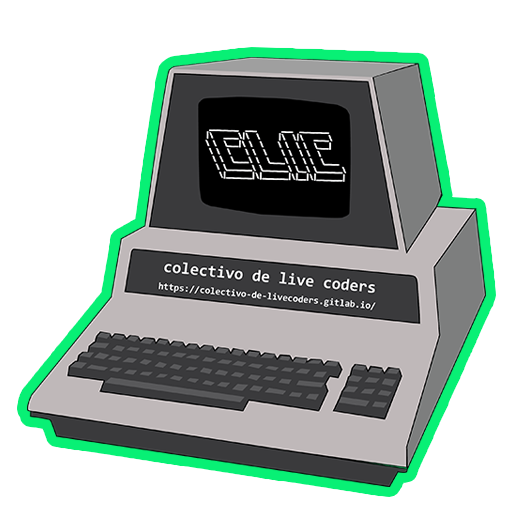Chronology
CLiC – Live Coders Collective (in spanish Colectivo de Live Coders) was founded in september 2018 by a group of people from La Plata, Argentina seeking to meet and produce through live coding techniques.
We all come from differents approaches: programming, music, drawing, design. We are actually ~56 members in the online comunity.
We did our first encounters in our homes, later in the Computer Science University and the Fine Arts University campus. Also created a channel in Lurk and bridged it to a Telegram group to have something more mobile.
We started to livecode in pubs/bars/festivals, https://colectivo-de-livecoders.gitlab.io/#fechas, and we did the first algorave.
First local algorave
We organized and performed the first algorave of La Plata city, as part of TOPLAP‘s 15th birthday. This had been building up from a few intense months of organizing ourselves.
Manifest
In our manifest we say:
What are we?
A space for collective exchange and production, open, careful, horizontal and adhocratic to address, investigate and perform using livecoding tools and techniques
Open: in the sense that any participation, proposals, ideas, tools are welcome.
Of exchange and production: because we consider that knowledge is a social community construction, and belongs to the community, not the individual (therefore, the next point)
Collective and open: anyone can be part of the collective as long as they feel like and can carry forward the ideas presented in this manifest.
Adhocratic and horizontal: because there is no hierarchy, there are no owners, directors, or masters. We reject the me-isms, egocentrism and pedantic pedagogy.
Exchange and production: the ultimate goal is to be able to investigate, learn, carry out artistic, performative proposals, gigs, perform and enjoy ourselves.
Be mindful: we do not allow offensive or devalorizing comments of any kind; related to gender, identity, sexual orientation, different abilities, physical appearance, body size, musical tastes or uses of software tools.
Code of Co-existence
Let it be a safe space:
A place where each of us individually and as a group feel free, comfortable and in an empathic space fit for exchanging.
Welcome:
Any person who is interested in participating or being aware of what we do here, can enter the channel/space/group (from now on “space”). If this is your first time here, we invite you to introduce yourself (only if you feel like it and we’d like to make clear it’s not necessary to give real data of yourself, with a nick it’ll suffice) and tell us what brought you here or what you find interesting from this. <3
Important:
– When exchanging technical knowledge, try to involve everyone (conversations of all-cis-man-from-computer-science are a thing of the past!). We understand that what’s lacking are spaces to learn among and with each other.
– We do not tolerate mansplaining. Be aware of not having this attitude towards the cis woman, trans, transvestites or lesbians of the group. We do not tolerate that practice.
– We do not tolerate trolls. We won’t allow under any circumstance: harrasment or bullying of other people; sexits, racist, fascist or any discriminatory comments; sharing content which isn’t aligned with this code of conduct (and with this particular item specifically) without a context, critic or theory as to why the content is shared.
– If you’re going to record or take pictures, say it out loud so people are aware and can give their consent or not.
We try to apply all this rules to all the people that share this space. If they aren’t complying, they will be collectively asked to leave.
tidal-bridge
We had wishes to play all together using tidal and hydra. Also, we had some tehcnical limitations: 1 video projector, multiple tidals, single stereo output.
After trying some alternatives configuring a multi-machine setup with no succcess, we decided to give a go to a custom solution, easy to setup and synchronize.
So we developed tidal-bridge. Is basically a web-based text editor that sends code to a server that runs a single SuperDirt instance and spawns multiple tidal processes, all in the same machine. That makes it straightforward to synchronize all the tidals and have a single sound output.
Then another machine runs Hydra, and connects to the same server, from where it receives the tidal code evaluated in the editors, that way, with a single projector we can display both hydra code and visuals, and the tidal code that’s driving the sound.
It also proved to be an amazing tool to run workshops and learn.
It’s free software and published under GPLv3 licence.
We are currently working on an expansion that will include other languages and the ability to have more projectors showing both, code and visuals.
Blog
In our blog we publish texts, translate some to spanish, and generate a space to debate.
Future and contact
We are open to people willing to join, let’s meet in the #clic channel.
Bests,
CLiC


